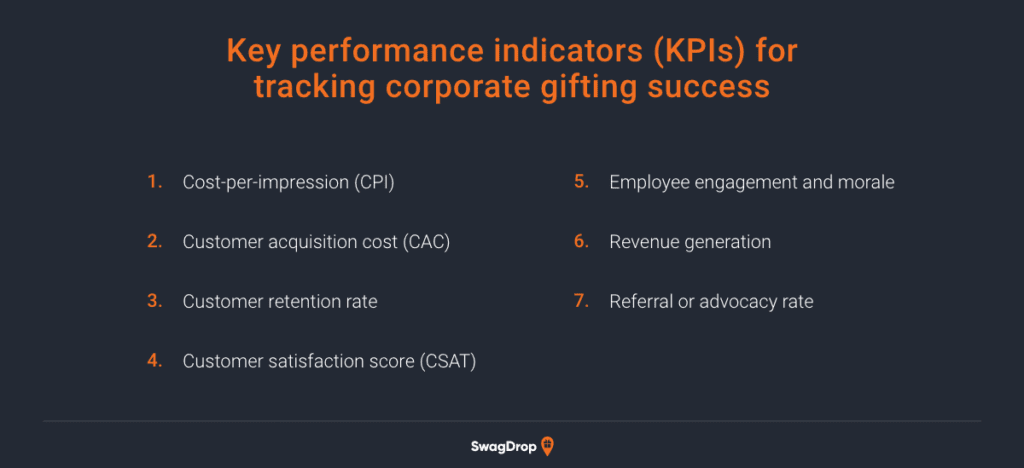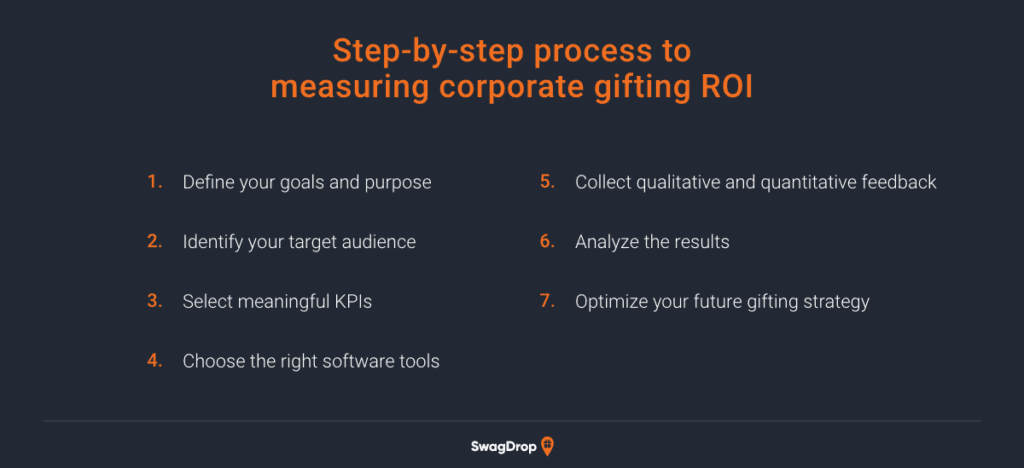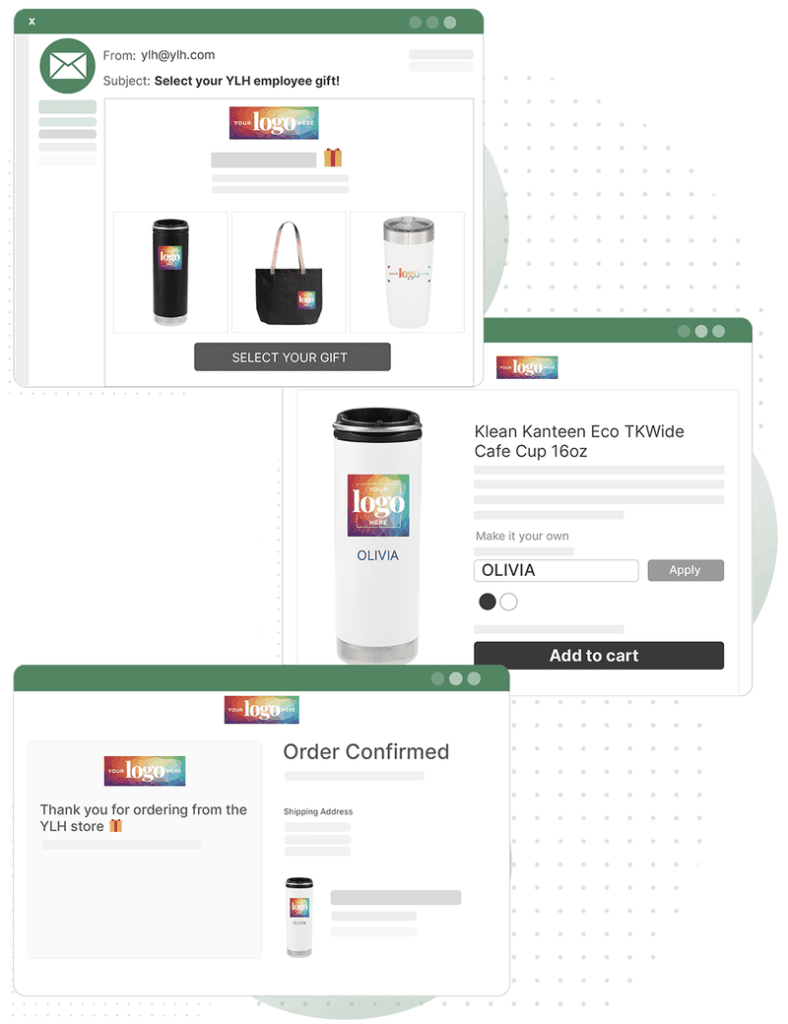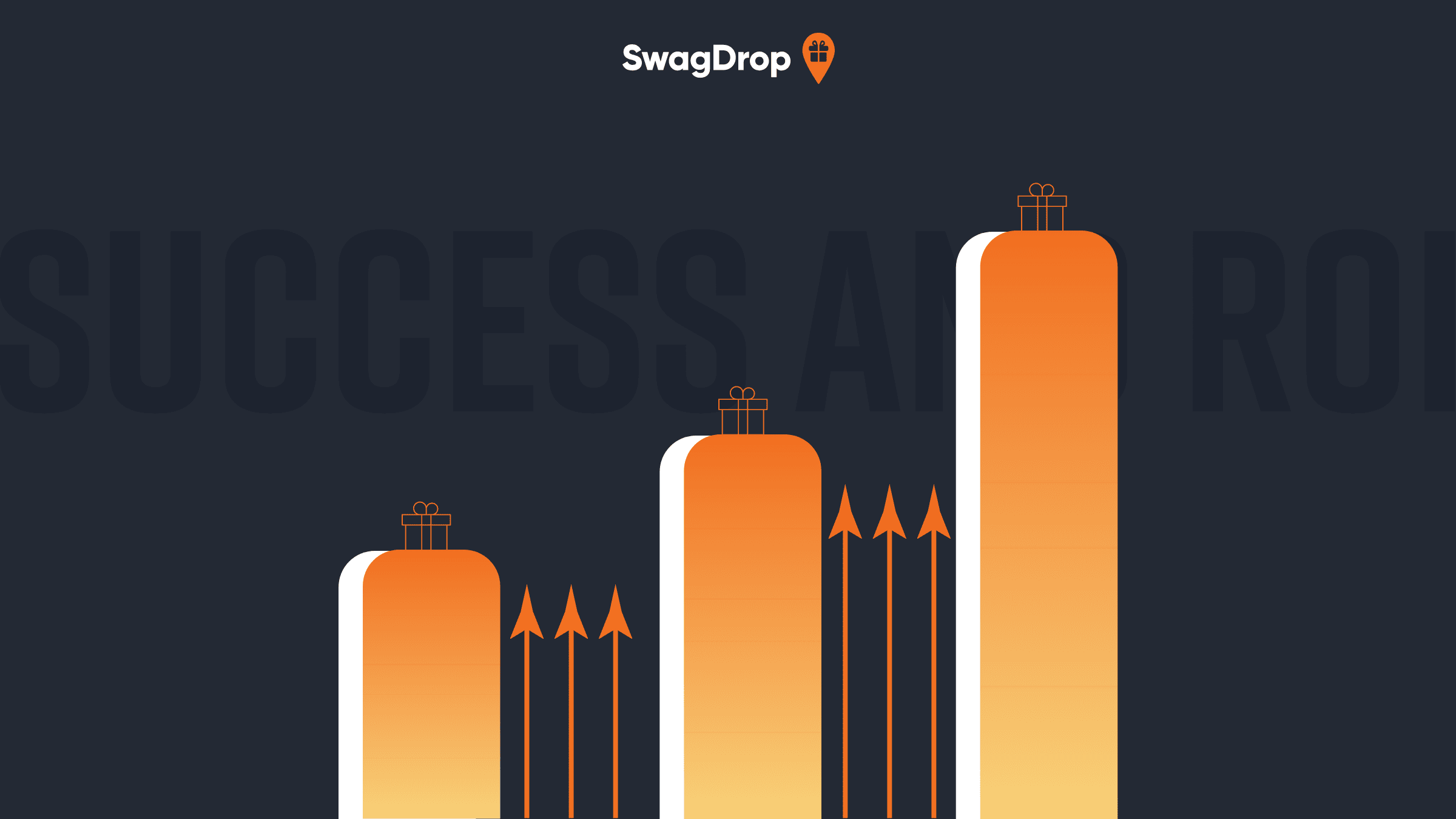A well-chosen corporate gift can build relationships, boost morale, and strengthen brand loyalty.
Yet, HR professionals, office managers, and corporate marketers have to prove that this strategy is worth the investment.
If you’re wondering how to show the ROI of your gifting programs or where to start, you’re in the right place.
In this guide, we’ll break down what ROI really means for corporate gifting, how to calculate it, and which KPIs are the most significant.
You’ll also learn how to measure internal impact, track recipient engagement, and simplify the entire gifting process with our swag-on-demand service.
Let’s get the ball rolling!

Table of Contents
What Is ROI in the Context of a Corporate Gifting Strategy?
How Is the ROI of Corporate Gifting Calculated?
What Are the Key Performance Indicators (KPIs) for Corporate Gifting Success?
How Do You Measure Internal Gifting ROI?
Step-By-Step Process to Measuring the Success and ROI of Corporate Gifting
How Do You Track Recipient Engagement with a Corporate Gift?
How SwagDrop’s Swag On-Demand Helps Streamline Corporate Gifting
What Is ROI in the Context of a Corporate Gifting Strategy?
ROI, or return on investment, is a simple way to measure how much value you gain compared to what you spend.
However, in corporate gifting, ROI means more than financial gains.
Apart from tracking sales growth or new leads, you should also analyze intangible returns, like stronger client relationships, better employee morale, and lasting brand loyalty.
For instance, when you send a thoughtful new hire welcome kit or a personalized customer appreciation gift, you’re building trust, appreciation, and connection.
These gestures can improve employee and client retention rates, engagement, and your brand reputation.
Therefore, ROI helps you show stakeholders that your corporate gifting program delivers real, measurable value, both financially and in terms of how people feel about your company.
Find out how to calculate ROI next.
How Is the ROI of Corporate Gifting Calculated?
The basic formula for calculating the ROI of corporate gifting looks like this:

Here, the Cost of Gifts includes everything you spend on each gift, such as the product price, packaging, shipping, and any platform or fulfillment service fees.
For example, if you spend $1,000 on client gifts and they generate $5,000 in upsell revenue, your ROI is 400%.
You can measure ROI for different types of corporate gifting campaigns, such as:
- Employee appreciation gifts that focus on boosting morale and productivity;
- Client gifts that aim to increase contract renewals or repeat business;
- Prospect gifts that improve lead conversion rates.
Likewise, you can estimate ROI by tracking increases in response rates, conversions, retention, or satisfaction.
These metrics help you project the tangible and intangible returns your campaigns generate.
Now, let’s explore which key performance indicators (KPIs) help you track gifting success.
What Are the Key Performance Indicators (KPIs) for Corporate Gifting Success?
Tracking the right key performance indicators (KPIs) makes all the difference in demonstrating the value of your corporate gifting campaigns.
These key metrics give you quantifiable, valuable insights into how your gifting efforts impact your business goals.
Here’s a quick look at seven of the most effective KPIs for tracking gifting success:

Let’s dive into what each one means and how to use it.
1. Cost-per-impression (CPI)
CPI shows how much each “view” of your branded products costs over their lifetime.
You calculate this KPI by dividing the total cost of a gift by the number of estimated impressions it makes over time.
For example, if you spend $500 on custom hoodies and estimate they’ll be seen 5,000 times, your CPI is $0.10.
The lower the CPI, the more brand visibility you gain for every dollar you invest.
This metric works best for reusable swag like branded apparel or drinkware, where impressions accumulate over time.
Interesting fact: According to the 2023 ASI report, outerwear generates the most impressions, surpassing even the highly popular t-shirts.
2. Customer acquisition cost (CAC)
CAC helps you understand how much it costs to win a new customer.
Gifting can reduce the cost by improving conversion rates during the sales process.
For instance, if you send a thoughtful gift during the sales journey, such as a branded notebook or snack box, you can turn leads into clients faster.
Compare acquisition costs before and after introducing corporate gifting to determine its real impact.
3. Customer retention rate
Retention reflects how well your gifts help keep clients coming back.
Client gifting strengthens long-term relationships by showing genuine appreciation beyond the financial gains.
Use your CRM to track how many customers renew their contracts or make purchases after receiving gifts.
Compare customer retention before and after introducing giveaways to identify the long-term effects of this business strategy.
4. Customer satisfaction score (CSAT)
CSAT captures how happy your recipients are with the gifting experience.
You can add gift-related questions to your existing surveys or send follow-ups asking about the experience.
Questions like “Did this gift meet your expectations?” or “How likely are you to recommend us?” offer valuable insights.
Based on the feedback you receive, you can make better gift choices and make sure they resonate with your audience.
5. Employee engagement and morale
This key metric focuses on how your internal teams feel after receiving a gift.
You can monitor employee engagement and workplace happiness using pulse surveys, polls, or recognition platforms.
At the same time, if you notice team members sharing photos of your gifts on social media or talking about the experience with their colleagues, it means you’re on the right track.
If employees feel seen and valued, morale and performance usually go up.
In fact, a recent Nectar survey found that employee recognition enhances engagement in 81.9% of workers and improves job satisfaction in 87% of workers.
6. Revenue generation
Revenue generation tracks how much money you gain from a corporate gifting campaign.
For instance, sending a meaningful promotional gift to a client can encourage upsells or renewals or make a prospect respond faster.
Analyze the revenue trends for customers that receive gifts to quantify the monetary return your gifting program delivers.
7. Referral or advocacy rate
The referral or advocacy rate shows if your gifts improve word-of-mouth.
If people share their unboxing moments on social media, leave stellar reviews, or refer new clients, your gifting campaign is a big hit.
Include referral links, QR codes, or discount cards in your packages, then track how many leads or mentions come in.
Each share or referral reflects real brand enthusiasm.
Next up, we’ll show you how to measure the ROI of employee gifting.
How Do You Measure Internal Gifting ROI?
Internal gifting is a powerful way to recognize and reward employees, increasing motivation and building long-term loyalty.
However, if you want your recognition program to be sustainable, you must measure the impact of corporate gifts on your team.
Here’s how you can track ROI on employee gifting programs.
Connect gifting to HR metrics
Determine how your gifting initiatives influence key HR metrics, including engagement, retention rate, and the employee Net Promoter Score (eNPS).
For example, track whether new employee welcome kits improve first-90-day retention. If you notice an improvement, it means your gifts help new hires feel welcomed and motivated to continue their career path within your company.
Gather post-gifting feedback
Send pulse surveys or quick feedback forms after gifting events.
Ask employees how the gift made them feel, if it increased their sense of belonging, or if it motivated them to become more productive at work.
Keep the surveys short and sweet to encourage higher response rates.
Monitor qualitative signals
Look for testimonials, internal chat mentions, and photos shared on Slack or Teams.
Frequent mentions typically signal genuine excitement and positive sentiment.
Doug Crawford, founder of Best-Trade-Schools.net, shared his thoughts on the matter:
“I’ve never believed in throwing money at gifts just to say we did something good. It has to mean something to the person receiving it.
When we get that right, I see better engagement in performance reviews, more openness in one-on-ones, and a stronger sense of community. You can’t fake that. You see the return in how connected people are, how often they go above what’s expected, and how loyal they become.
So I don’t plug gifting into a calculator. I look at what happens afterward. […] That’s the kind of ROI that matters in the long run.”
Now, let us walk you through measuring the success and ROI of all your corporate gifting programs.
Step-By-Step Process to Measuring the Success and ROI of Corporate Gifting
Measuring the ROI of corporate gifting is an ongoing cycle that involves planning, execution, and reflection.
This strategy helps you understand what’s working, where to adjust, and how to align your gifting efforts with broader business objectives, such as retention, morale, or revenue growth.
Here’s a quick step-by-step guide to effectively measuring the impact of corporate gifting:

Let’s take a closer look at each step.
1. Define your goals and purpose
Every successful campaign starts with setting clear objectives.
Connect each gift to a specific business goal, such as improving employee satisfaction or building customer loyalty.
Then, make those business objectives measurable. For instance, you can set targets like: “increase employee NPS by 15% in Q3” or “raise renewal rates by 10% over the next six months.”
Setting a timeline helps you stay focused and track progress.
2. Identify your target audience
Segment your gift recipients into categories like employees, clients, prospects, or partners.
Each group responds differently and values different outcomes.
For example, employee gifting can focus on morale and retention, while client gifting can target loyalty, partnerships, and referrals.
You should also consider the recipient’s preferences to make sure each gift feels personal and meaningful.
3. Select meaningful KPIs
Choose 3–5 KPIs that align with your business objectives, such as cost-per-impression, customer retention rate, and customer satisfaction scores.
Look at past data to set realistic benchmarks and make informed decisions about what’s working and what needs refinement.
4. Choose the right software tools
Use a modern corporate gifting platform like SwagDrop that lets recipients pick swag items that resonate with them, creating a more meaningful experience that gets results.
Since you only pay for what recipients order, you’ll have a clear view of the best-performing gifts and you can distribute your swag budget more effectively.
Implement analytics tools, such as CRM software or Google Analytics, that use automation to track post-gifting behavior.
Assign responsibility for tracking each KPI to obtain accurate measurements.
5. Collect qualitative and quantitative feedback
Use post-gift polls, internal chats, or follow-up calls to gather insights about satisfaction and usefulness.
For example, you can ask recipients how the gift made them feel, if they enjoyed the experience, and how it influenced their brand perception.
These responses help you determine the emotional impact and effectiveness of your corporate gifts.
6. Analyze the results
Compare the outcomes to your original business goals and KPIs.
Determine whether your gifting program generates higher retention, increased engagement, or improved business relationships.
Use dashboards, spreadsheets, and automation tools to identify patterns and measure ROI.
7. Optimize your future gifting strategy
Use the analysis findings to optimize your swag strategy.
Identify the strengths and weaknesses of your campaigns in terms of gift type, timing, and personalization, so you can improve.
Experiment with physical and virtual swag to see what resonates most with your audience.
The more data you gather, the better you can shape future campaigns for impact and efficiency.
A repeatable process and the right tools can help you create meaningful gifting programs that delight your audience and improve your company’s bottom line.
Coming up next, we’ll share some tips on tracking recipient engagement.
How Do You Track Recipient Engagement with a Corporate Gift?
Tracking how someone responds to a corporate gift helps you understand its true impact.
Once you see what resonates and what doesn’t, you can optimize your approach, boost engagement, and deliver more effective gifts in the future.
Here are a few smart ways to track recipient engagement.
Use trackable gift links
Include custom URLs, redemption links, or QR codes in your gift packaging or emails.
Once recipients scan or click these items, you can track gift activation, usage, and even which items spark the most interest.
Implement recipient-choice gifts
Let recipients pick their gifts from corporate gifting platforms offering on-demand services, like SwagDrop.
The gift selection data will help you understand which types of gifts resonate and spot trends in preferences so you can personalize future campaigns.
Track engagement metrics
Track gift invitation email open rates and click-through rates, as well as gift redemption rates.
These basic analytics offer a clear picture of initial interest and follow-through.
If the redemption numbers are low, you should look for more relevant promotional products or adjust the delivery method.
Collect feedback through surveys
After your gift arrives, follow up with a short satisfaction survey.
Ask recipients about their overall gift experience and seek recommendations for future campaigns.
Based on this feedback, you can improve your corporate gifting programs.
Add a personal touch
Reach out personally to top clients or employees after gifting.
A quick call or message can uncover valuable insights that digital tracking might miss.
Use this qualitative feedback to optimize future gifting campaigns.
Monitor social channels
Use social listening to identify social media mentions, photos, or reviews related to your gifts.
Positive posts and organic sharing signal genuine excitement and advocacy for your brand.
Combining digital tracking with human follow-up gives you a complete view of gift performance and helps you make smarter, more personalized gift choices going forward.
Now, let us show you how SwagDrop can streamline your gifting workflow.
How SwagDrop’s Swag On-Demand Helps Streamline Corporate Gifting
SwagDrop’s swag-on-demand service helps you take the stress out of corporate gifting by giving you a smarter, more flexible way to deliver gifts.
Here’s how we can help you simplify and elevate your gifting strategy.
Gives recipients the power to choose
At SwagDrop, we build you branded online gift shops for any occasion, including new hire onboarding, milestone celebrations, and customer appreciation.
The best part is that recipients can choose the company swag that suits their style.
In our vast collection of high-quality promotional products, including everything from fashionable apparel and sleek drinkware to eco-friendly products and high-tech gadgets, everyone finds something to their liking.
For an extra special touch, we let recipients personalize select promo items with their name or a short phrase.
This approach guarantees that your clients and employees receive something they genuinely want, increasing satisfaction and leaving a lasting impression.

Saves time and helps you stay on budget
You don’t need to worry about inventory management or shipping logistics because we take care of it for you.
Our swag-on-demand model is a cost-effective solution that delivers gifts straight to your recipients’ doorsteps.
As a bonus, setting up your gift shop, storing your swag, and handling order fulfillment won’t cost you a thing.
You only pay for the branded merchandise your recipients choose and a flat $9.95 shipping fee per order.
Therefore, you’ll get all the benefits of a premium gifting experience without overloading your HR, marketing, or sales teams.

Enables light tracking for better insights
While SwagDrop doesn’t offer detailed ROI analytics, you can monitor gift selection and delivery completion from beginning to end.
This data gives you indirect insights into engagement levels and recipient preferences, helping you make more informed gifting decisions over time.
Now, let’s finish this up!
Tips, tricks, and inspiration delivered straight to your inbox.
Final Thoughts on Measuring Corporate Gifting Success
Measuring the success of your corporate gifting program helps you turn thoughtful gestures into strategic wins.
If you track the right data and align your gifts with business goals, you can prove their impact on everything from employee satisfaction to customer loyalty.
Every campaign offers new insights, helping you optimize your approach and maximize ROI.
Browse our SwagDrop shop to find fabulous corporate gift ideas that will wow recipients and support your ROI goals.


